A High-Phosphorus-Content Polyphosphonate with Combined Phosphorus Structures for Flame Retardant PET
Abstract
1. Introduction
2. Experimental
2.1. Materials
2.2. Synthesis of Polyphosphonate
2.3. Preparation of PET Composites
2.4. Instruments
3. Results and Discussion
3.1. Chemical Structure and Pyrolysis Behavior of PDBA
3.2. Thermal Decomposition Behavior Analysis
3.3. Pyrolysis Products Analysis of PDBA
3.4. Flammability
3.5. Cone Calorimeter Testing
3.6. Physical and Chemical Analysis of Char Residue
3.7. Gas-Phase Products Analysis
3.8. Hot Stage FTIR Analysis of Residues
4. Conclusions
Author Contributions
Funding
Institutional Review Board Statement
Data Availability Statement
Conflicts of Interest
References
- Guo, D.M.; Chen, X.Q.; Tang, L.; Wu, J.N.; Fu, T.; Wang, X.L.; Wang, X.L.; Chen, L.; Wang, Y.Z. PET-based copolyesters with bisphenol A or bisphenol F structural units: Their distinct differences in pyrolysis behaviours and flame-retardant performances. Polym. Degrad. Stabil. 2015, 120, 158–168. [Google Scholar] [CrossRef]
- Kim, Y.H.; Jang, J.; Song, K.G.; Lee, E.S.; Ko, S.V. Durable flame-retardant treatment of polyethylene terephthalate (PET) and PET/cotton blend using dichlorotribromophenyl phosphate as new flame retardant for polyester. J. Appl. Polym. Sci. 2001, 81, 793–799. [Google Scholar] [CrossRef]
- Lim, K.S.; Bee, S.T.; Sin, L.T.; Tee, T.T.; Ratnam, C.T.; Hui, D.; Rahmat, A.R. A review of application of ammonium polyphosphate as intumescent flame retardant in thermoplastic composites. Compos. Part B-Eng. 2016, 84, 155–174. [Google Scholar] [CrossRef]
- Liu, B.W.; Zhao, H.B.; Wang, Y.Z. Advanced Flame-Retardant Methods for Polymeric Materials. Adv. Mater. 2022, 34, 2107905. [Google Scholar] [CrossRef] [PubMed]
- Tian, X.J.; Huang, S.; Wang, J.J.; Yang, P.C.; Yang, K. Synthesis and Properties of Polyphosphoester and Diphenyl Phosphoroxy Derivative for Flame Retardant Poly(ethylene terephthalate). J. Photopolym. Sci. Technol. 2018, 31, 689–697. [Google Scholar] [CrossRef]
- Song, Y.H.; Xue, B.X.; Wang, J.; Qin, R.H.; Niu, M. Ammonium polyphosphate wrapped carbon microspheres: A novel flame retardant with smoke suppression for poly (ethylene terephthalate). J. Polym. Res. 2019, 27, 2. [Google Scholar] [CrossRef]
- Varganici, C.D.; Rosu, L.; Bifulco, A.; Rosu, D.; Mustata, F.; Gaan, S. Recent advances in flame retardant epoxy systems from reactive DOPO-based phosphorus additives. Polym. Degrad. Stabil. 2022, 202, 110020. [Google Scholar] [CrossRef]
- Aytan, E.; Aytan, T.A.; Kahraman, M.V. Phosphorus Ester Containing Mesoporous Silica as Novel High-Effective Flame Retardant in Polyurethane and Polyester Coatings. Chemistryselect 2021, 6, 6541–6547. [Google Scholar] [CrossRef]
- Brehme, S.; Koppl, T.; Schartel, B.; Fischer, O.; Altstadt, V.; Pospiech, D.; Doring, M. Phosphorus Polyester—An Alternative to Low-Molecular-Weight Flame Retardants in Poly(Butylene Terephthalate)? Macromol. Chem. Phys. 2012, 213, 2386–2397. [Google Scholar] [CrossRef]
- Gu, L.; Chen, G.; Yao, Y. Two novel phosphorus–nitrogen-containing halogen-free flame retardants of high performance for epoxy resin. Polym. Degrad. Stabil. 2014, 108, 68–75. [Google Scholar] [CrossRef]
- Huo, S.; Song, P.; Yu, B.; Ran, S.; Chevali, V.S.; Liu, L.; Fang, Z.; Wang, H. Phosphorus-containing flame retardant epoxy thermosets: Recent advances and future perspectives. Prog. Polym. Sci. 2021, 114, 101366. [Google Scholar] [CrossRef]
- Xu, B.; Liu, Y.T.; Wei, S.M.; Zhao, S.H.; Qian, L.J.; Chen, Y.J.; Shan, H.; Zhang, Q.L. A Phosphorous-Based Bi-Functional Flame Retardant Based on Phosphaphenanthrene and Aluminum Hypophosphite for an Epoxy Thermoset. Int. J. Mol. Sci. 2022, 23, 11256. [Google Scholar] [CrossRef]
- Xu, Y.J.; Wang, J.; Tan, Y.; Qi, M.; Chen, L.; Wang, Y.Z. A novel and feasible approach for one-pack flame-retardant epoxy resin with long pot life and fast curing. Chem. Eng. J. 2018, 337, 30–39. [Google Scholar] [CrossRef]
- Pospiech, D.; Haussler, L.; Korwitz, A.; Fischer, O.; Starke, S.; Jehnichen, D.; Koppl, T.; Altstadt, V. The miscibility of poly(butylene terephthalate) (PBT) with phosphorus polyester flame retardants. High Perform. Polym. 2012, 24, 64–73. [Google Scholar] [CrossRef]
- Deng, Y.; Wang, Y.Z.; Ban, D.M.; Liu, X.H.; Zhou, Q. Burning behavior and pyrolysis products of flame-retardant PET containing sulfur-containing aryl polyphosphonate. J. Anal. Appl. Pyrolysis 2006, 76, 198–202. [Google Scholar] [CrossRef]
- Deo, H.T.; Patel, N.K.; Patel, B.K. Eco-friendly Flame Retardant (FR) Pet Fibers Through P-N Synergism. J. Eng. Fibers Fabr. 2008, 3, 23–38. [Google Scholar] [CrossRef]
- Chruściel, J.J.; Leśniak, E. Modification of epoxy resins with functional silanes, polysiloxanes, silsesquioxanes, silica and silicates. Prog. Polym. Sci. 2015, 41, 67–121. [Google Scholar] [CrossRef]
- Taib, M.; Antov, P.; Savov, V.; Fatriasari, W.; Madyaratri, E.W.; Wirawan, R.; Osvaldova, L.M.; Hua, L.S.; Ghani, M.A.A.; Al Edrus, S.; et al. Current progress of biopolymer-based flame retardant. Polym. Degrad. Stabil. 2022, 205, 110153. [Google Scholar] [CrossRef]
- Sun, D.; Yao, Y. Synthesis of three novel phosphorus-containing flame retardants and their application in epoxy resins. Polym. Degrad. Stabil. 2011, 96, 1720–1724. [Google Scholar] [CrossRef]
- Zhang, J.H.; Kong, Q.H.; Wang, D.Y. Simultaneously improving the fire safety and mechanical properties of epoxy resin with Fe-CNTs via large-scale preparation. J. Mater. Chem. A 2018, 6, 6376–6386. [Google Scholar] [CrossRef]
- Zhang, N.S.; Shen, J.L.; Pasquinelli, M.A.; Hinks, D.; Tonelli, A.E. Formation and characterization of an inclusion complex of triphenyl phosphate and beta-cyclodextrin and its use as a flame retardant for polyethylene terephthalate. Polym. Degrad. Stabil. 2015, 120, 244–250. [Google Scholar] [CrossRef]
- Zhang, Y.; Ni, Y.P.; He, M.X.; Wang, X.L.; Chen, L.; Wang, Y.Z. Phosphorus-containing copolyesters: The effect of ionic group and its analogous phosphorus heterocycles on their flame-retardant and anti-dripping performances. Polymer 2015, 60, 50–61. [Google Scholar] [CrossRef]
- Zhong, L.; Zhang, K.-X.; Wang, X.; Chen, M.-J.; Xin, F.; Liu, Z.-G. Synergistic effects and flame-retardant mechanism of aluminum diethyl phosphinate in combination with melamine polyphosphate and aluminum oxide in epoxy resin. J. Therm. Anal. Calorim. 2018, 134, 1637–1646. [Google Scholar] [CrossRef]
- Li, S.; Zhao, X.; Liu, X.; Yang, X.; Yu, R.; Zhang, Y.; Huang, W.; Deng, K. Cage-ladder-structure, phosphorus-containing polyhedral oligomeric silsesquinoxanes as promising reactive-type flame retardants for epoxy resin. J. Appl. Polym. Sci. 2019, 136, 47607. [Google Scholar] [CrossRef]
- Howell, B.A. Thermal Degradation of Organophosphorus Flame Retardants. Polymers 2022, 14, 4929. [Google Scholar] [CrossRef] [PubMed]
- Chu, F.K.; Zhou, X.; Mu, X.W.; Zhu, Y.L.; Cai, W.; Zhou, Y.F.; Xu, Z.M.; Zou, B.; Mi, Z.Z.; Hu, W.Z. An insight into pyrolysis and flame retardant mechanism of unsaturated polyester resin with different valance states of phosphorus structures. Polym. Degrad. Stabil. 2022, 202, 110026. [Google Scholar] [CrossRef]
- Howell, B.A.; Daniel, Y.G. The impact of sulfur oxidation level on flame retardancy. J. Fire Sci. 2018, 36, 518–534. [Google Scholar] [CrossRef]
- Qiu, Y.; Qian, L.; Feng, H.; Jin, S.; Hao, J. Toughening Effect and Flame-Retardant Behaviors of Phosphaphenanthrene/Phenylsiloxane Bigroup Macromolecules in Epoxy Thermoset. Macromolecules 2018, 51, 9992–10002. [Google Scholar] [CrossRef]
- Liu, Y.T.; Xu, B.; Qian, L.J.; Chen, Y.J.; Qiu, Y. Impact on flame retardancy and degradation behavior of intumescent flame-retardantEPcomposites by a hyperbranched triazine-based charring agent. Polym. Adv. Technol. 2020, 31, 3316–3327. [Google Scholar] [CrossRef]
- Ma, W.; Xu, B.; Shao, L.S.; Liu, Y.T.; Chen, Y.J.; Qian, L.J. Synthesis of (1,4-Methylenephenylphosphinic acid) Piperazine and Its Application as a Flame Retardant in Epoxy Thermosets. Macromol. Mater. Eng. 2019, 304, 1900419. [Google Scholar] [CrossRef]
- Shao, L.S.; Xu, B.; Ma, W.; Wang, J.Y.; Liu, Y.T.; Qian, L.J. Flame retardant application of a hypophosphite/cyclotetrasiloxane bigroup compound on polycarbonate. J. Appl. Polym. Sci. 2020, 137, 48699. [Google Scholar] [CrossRef]
- Feng, X.; Li, G. Catalyst-free β-hydroxy phosphate ester exchange for robust fire-proof vitrimers. Chem. Eng. J. 2021, 417, 129132. [Google Scholar] [CrossRef]
- Xu, B.; Wu, X.; Ma, W.; Qian, L.; Xin, F.; Qiu, Y. Synthesis and characterization of a novel organic-inorganic hybrid char-forming agent and its flame-retardant application in polypropylene composites. J. Anal. Appl. Pyrolysis 2018, 134, 231–242. [Google Scholar] [CrossRef]
- Qian, L.J.; Li, L.J.; Chen, Y.J.; Xu, B.; Qiu, Y. Quickly self-extinguishing flame retardant behavior of rigid polyurethane foams linked with phosphaphenanthrene groups. Compos. Part B-Eng. 2019, 175, 107186. [Google Scholar] [CrossRef]
- Wang, L.-S.; Kang, H.-B.; Wang, S.-B.; Liu, Y.; Wang, R. Solubilities, thermostabilities and flame retardance behaviour of phosphorus-containing flame retardants and copolymers. Fluid Phase Equilibria 2007, 258, 99–107. [Google Scholar] [CrossRef]
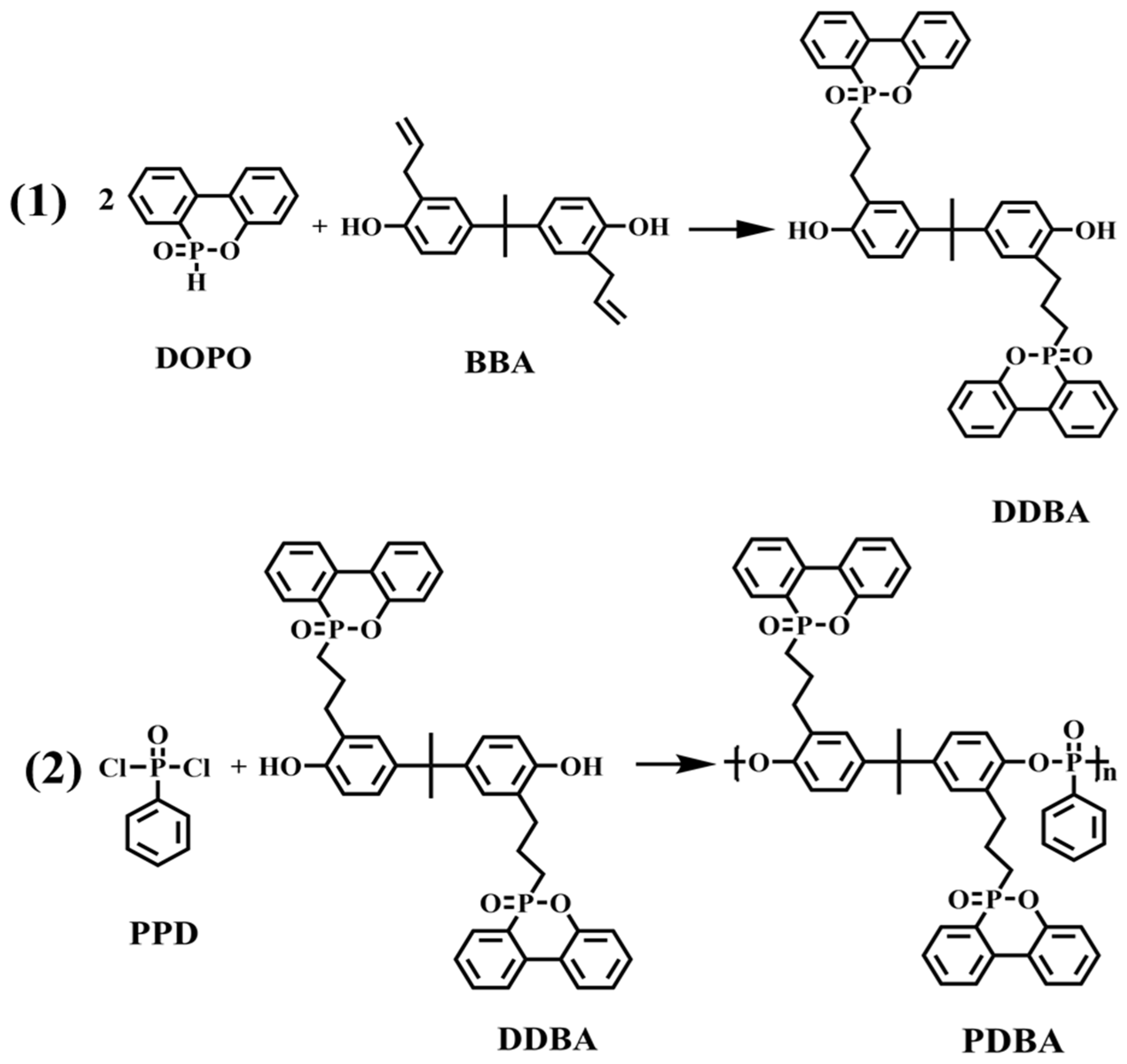
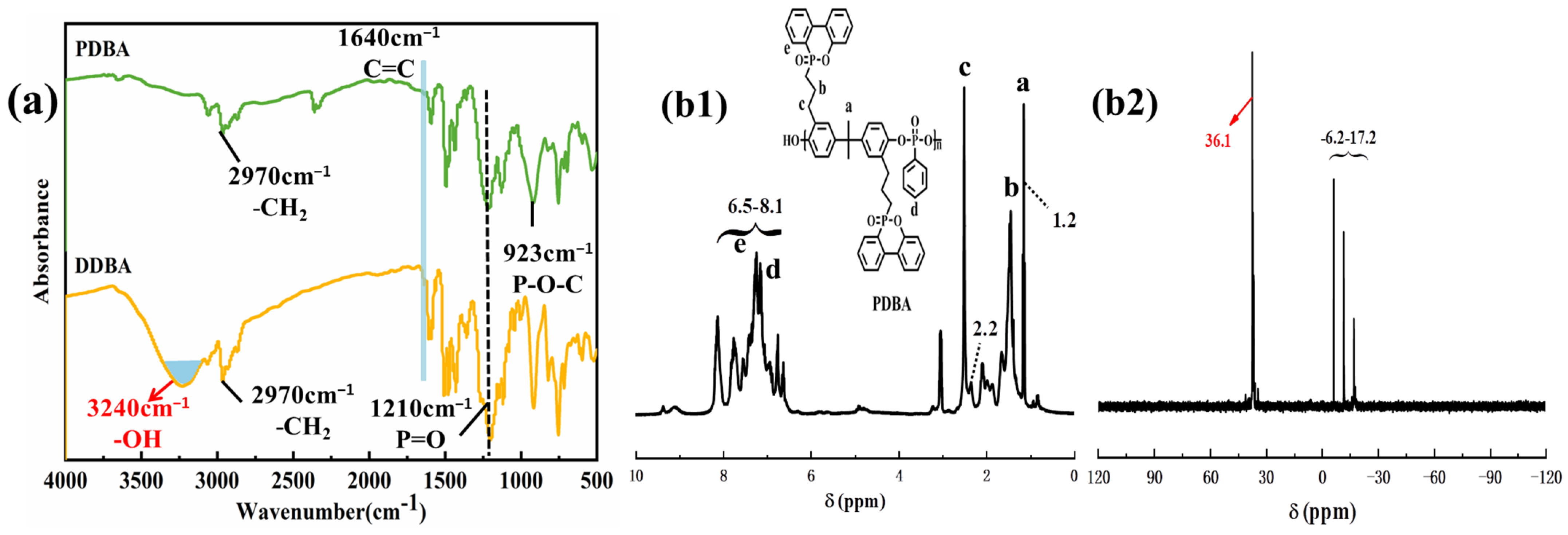
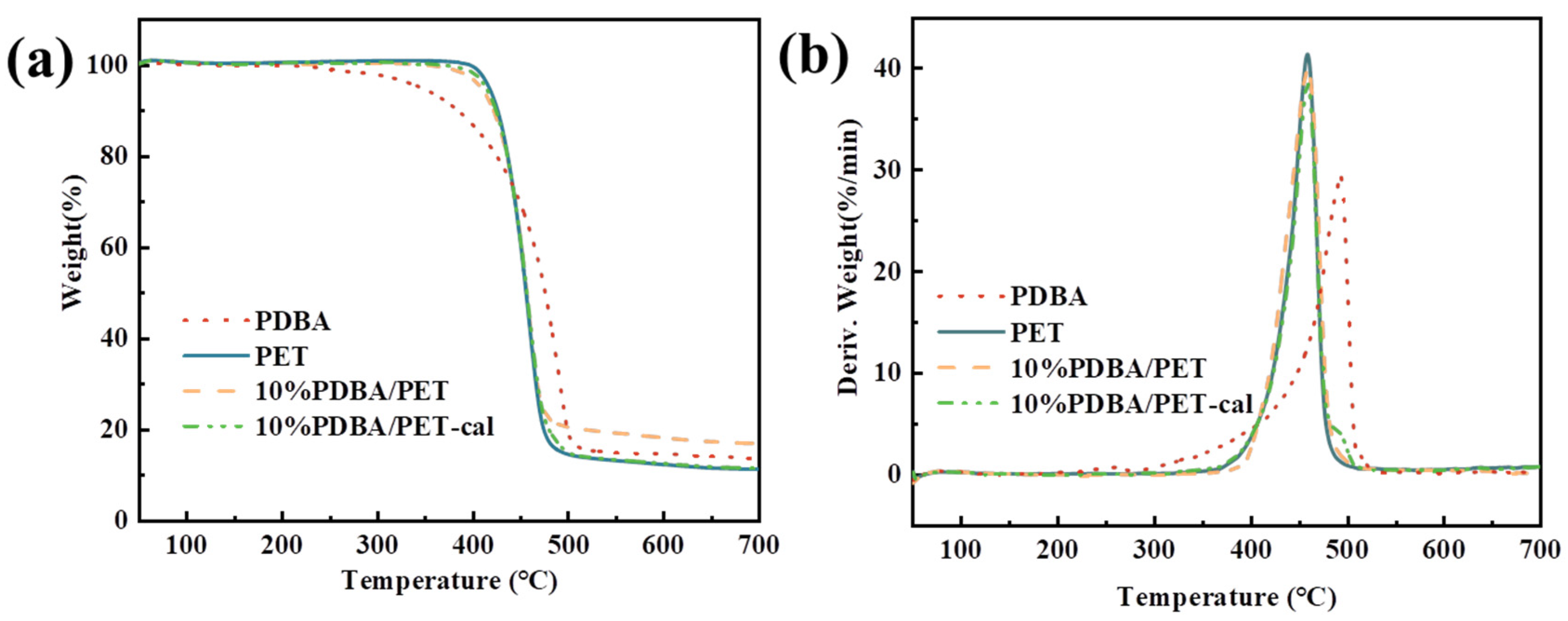
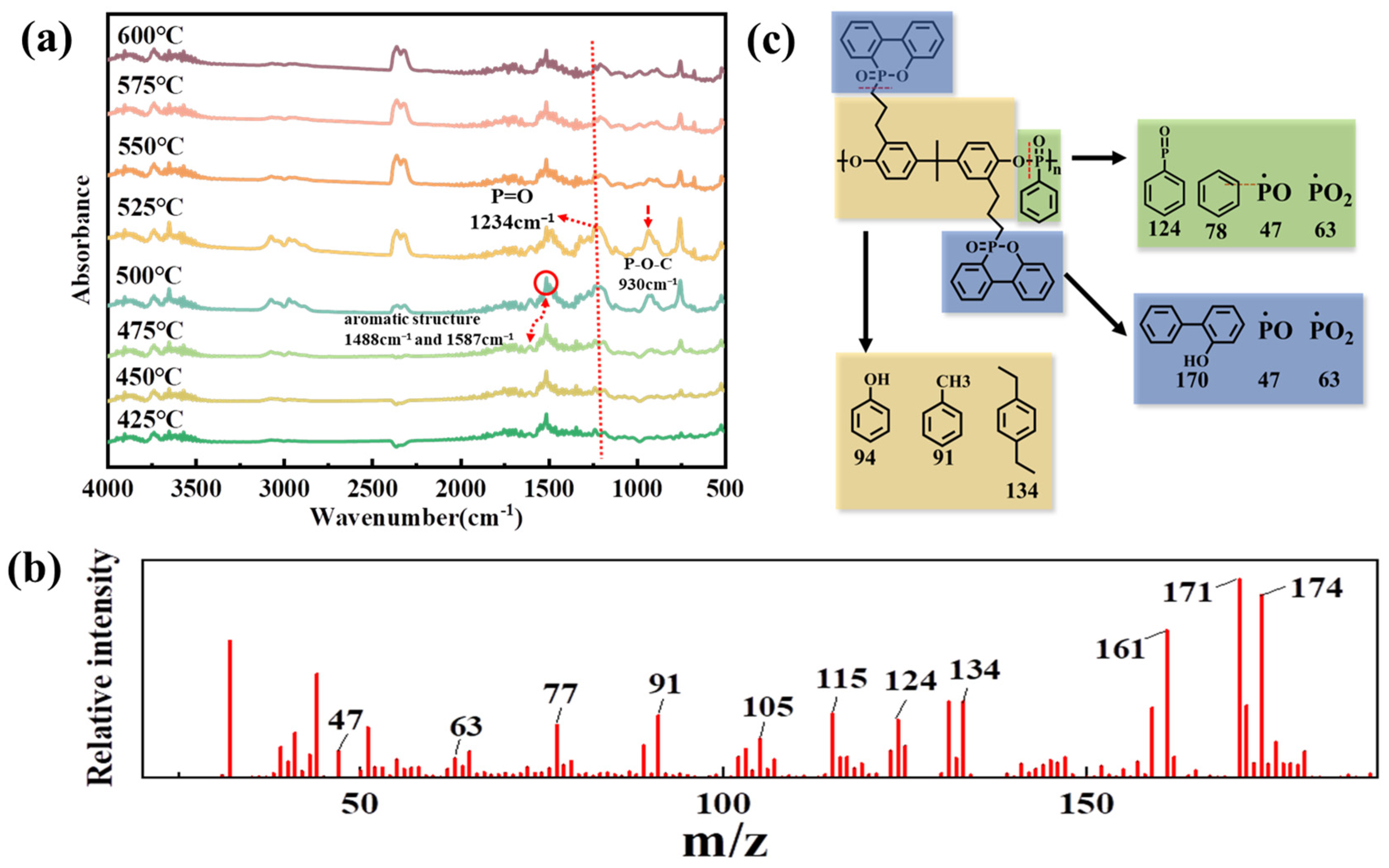
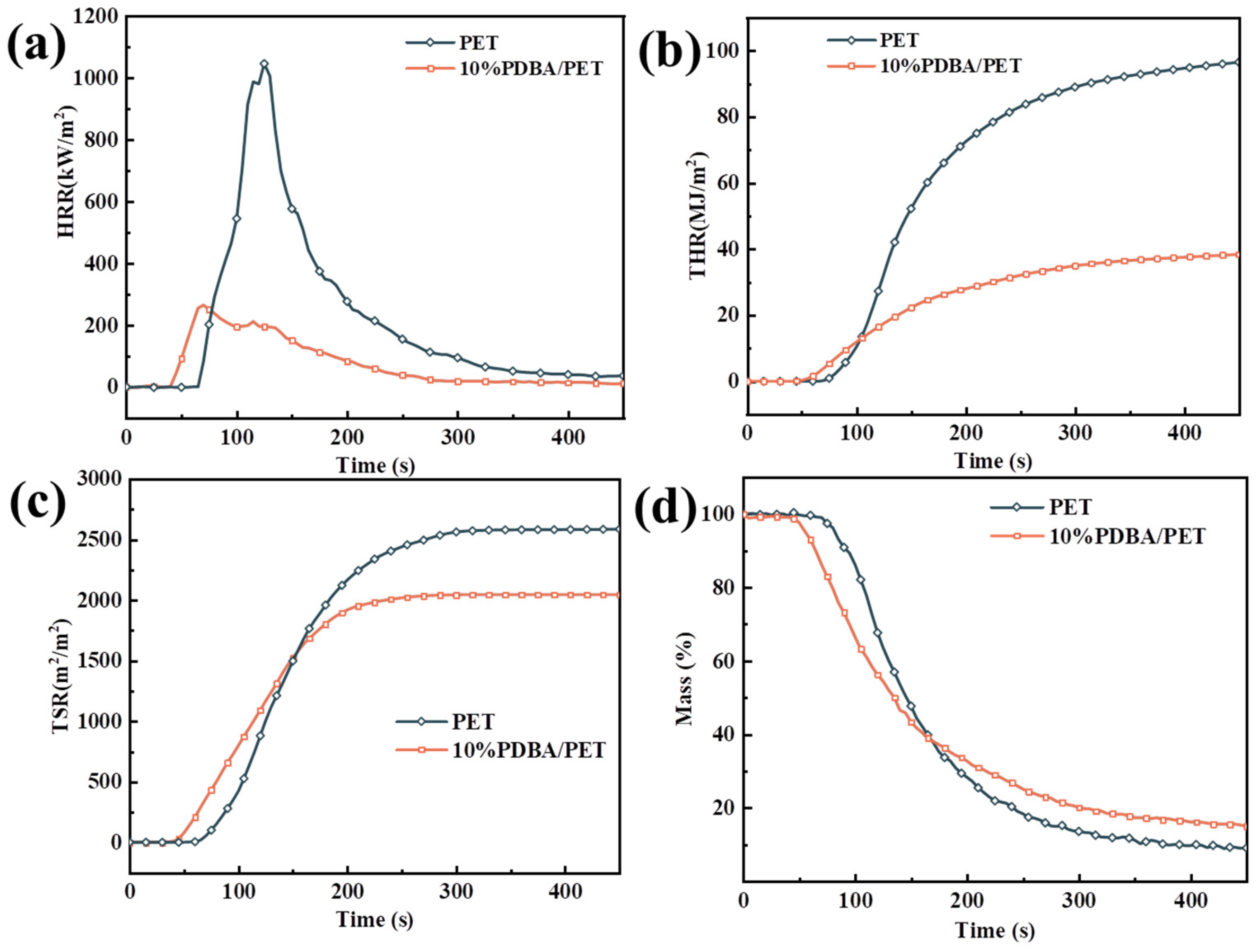
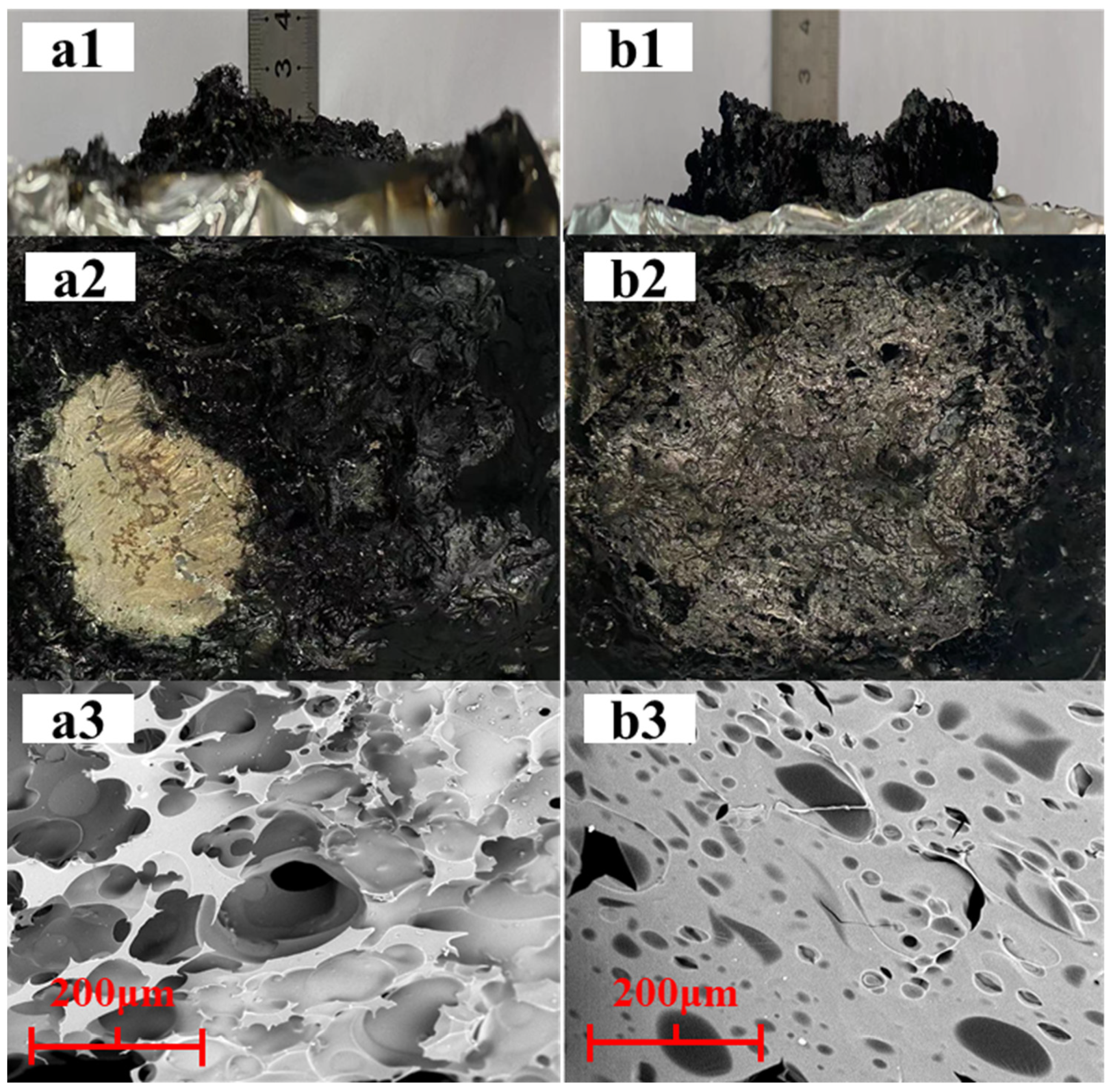
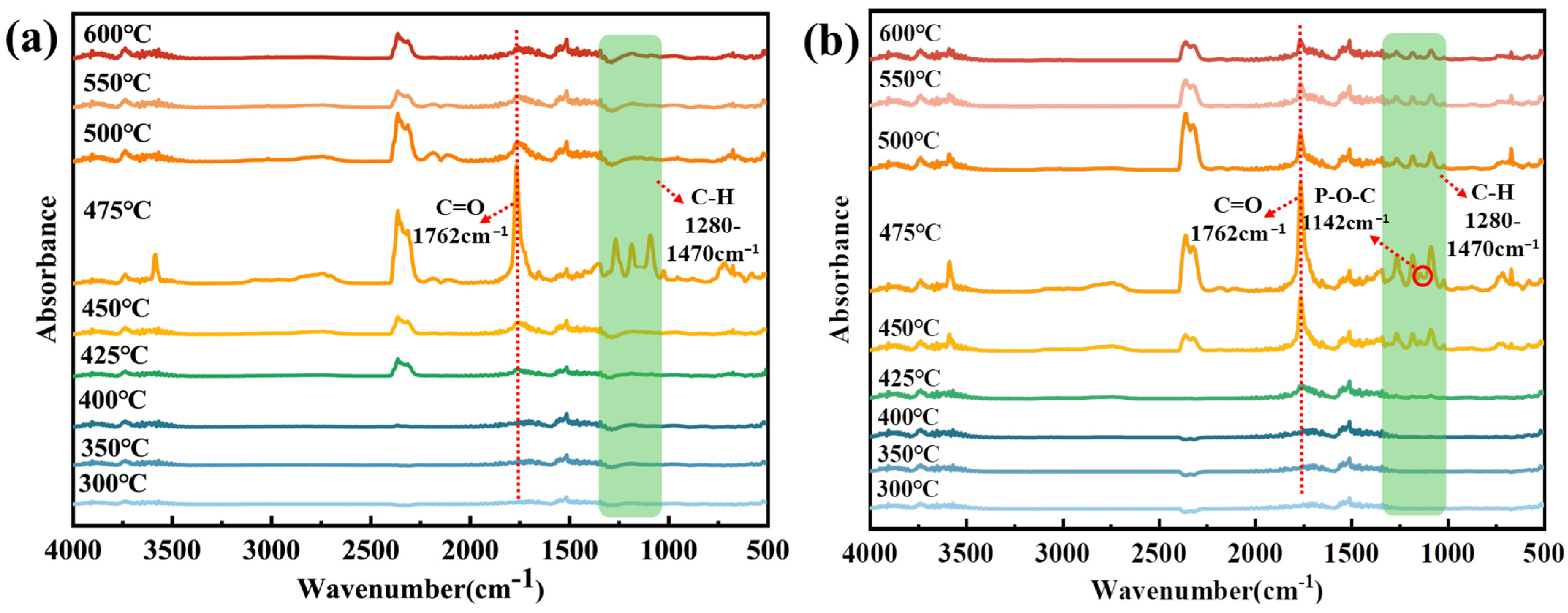
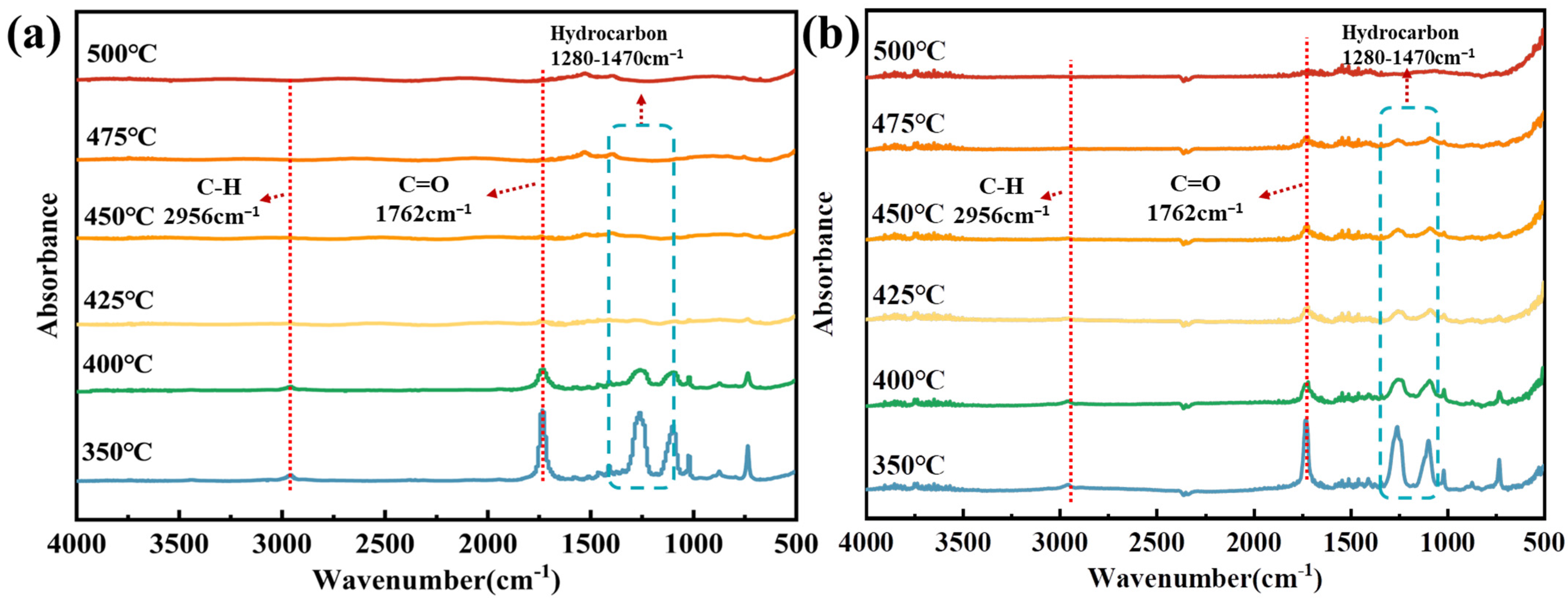
| Samples | Td.5% (°C) | Tpeak (°C) | Rpeak (%/min) | Residuals (wt.%) |
|---|---|---|---|---|
| PDBA | 345 | 490 | 28.7 | 13.7 |
| Pure PET | 417 | 459 | 40.0 | 11.3 |
| 10%PDBA/PET | 407 | 460 | 39.4 | 17.0 |
| 10%PDBA/PET-cal | 414 | 460 | 38.4 | 11.5 |
| Samples | LOI (%) | UL-94 | |||
|---|---|---|---|---|---|
| Dripping | Igniting | Rating | av-t1/t2(s) | ||
| Pure PET | 20.4 | YES | YES | V-2 | 21.3/15.1 |
| 5% PDBA/PET | 24.3 | YES | YES | V-2 | 5.0/6.4 |
| 10% PDBA/PET | 28.7 | YES | NO | V-0 | 2.7/1.2 |
| Sample | pHRR (kW/m2) | THR (MJ/m2) | av-EHC (MJ/kg) | TSR (m2/m2) | av-COY (kg/kg) | av-CO2Y (kg/kg) | Residue (wt.%) |
|---|---|---|---|---|---|---|---|
| PET | 1240.0 | 97.2 | 20.8 | 2580.6 | 0.070 | 2.21 | 9.1 |
| 10% PDBA/PET | 265.3 | 38.4 | 10.9 | 2036.1 | 0.109 | 1.23 | 15.0 |
| Samples | P Ratio in Residues (%) | Char Yield (%) | Initial P Ratio in Samples (%) | Reserved P Ratio in Total P (%) | Released P Ratio in Total P (%) |
|---|---|---|---|---|---|
| PDBA/PET | 1.73 | 17.0 | 0.93 | 31.6% | 68.4% |
Disclaimer/Publisher’s Note: The statements, opinions and data contained in all publications are solely those of the individual author(s) and contributor(s) and not of MDPI and/or the editor(s). MDPI and/or the editor(s) disclaim responsibility for any injury to people or property resulting from any ideas, methods, instructions or products referred to in the content. |
© 2023 by the authors. Licensee MDPI, Basel, Switzerland. This article is an open access article distributed under the terms and conditions of the Creative Commons Attribution (CC BY) license (https://creativecommons.org/licenses/by/4.0/).
Share and Cite
Xu, B.; Zhu, S.; Zhao, S.; Wang, X. A High-Phosphorus-Content Polyphosphonate with Combined Phosphorus Structures for Flame Retardant PET. Polymers 2023, 15, 1713. https://doi.org/10.3390/polym15071713
Xu B, Zhu S, Zhao S, Wang X. A High-Phosphorus-Content Polyphosphonate with Combined Phosphorus Structures for Flame Retardant PET. Polymers. 2023; 15(7):1713. https://doi.org/10.3390/polym15071713
Chicago/Turabian StyleXu, Bo, Shouao Zhu, Siheng Zhao, and Xiangdong Wang. 2023. "A High-Phosphorus-Content Polyphosphonate with Combined Phosphorus Structures for Flame Retardant PET" Polymers 15, no. 7: 1713. https://doi.org/10.3390/polym15071713
APA StyleXu, B., Zhu, S., Zhao, S., & Wang, X. (2023). A High-Phosphorus-Content Polyphosphonate with Combined Phosphorus Structures for Flame Retardant PET. Polymers, 15(7), 1713. https://doi.org/10.3390/polym15071713







